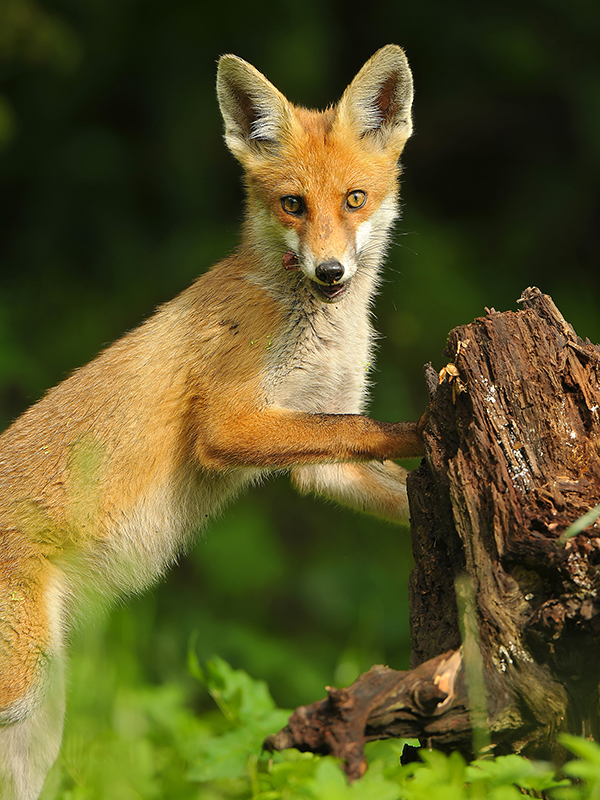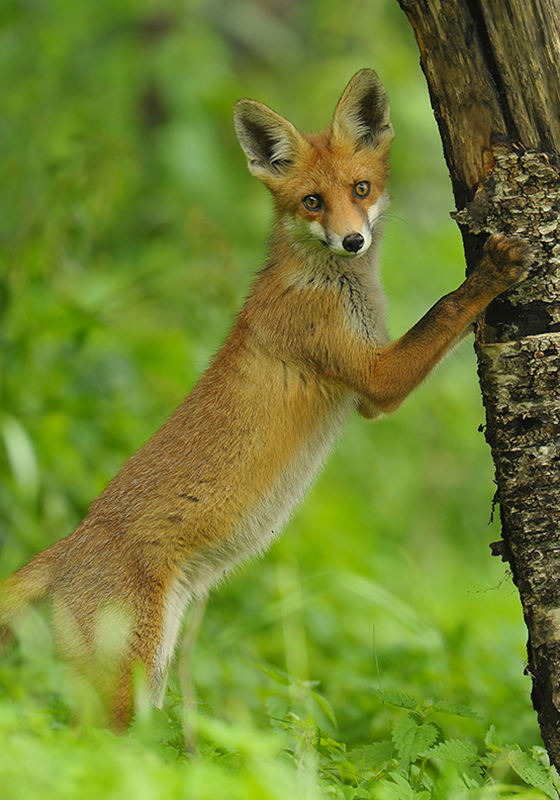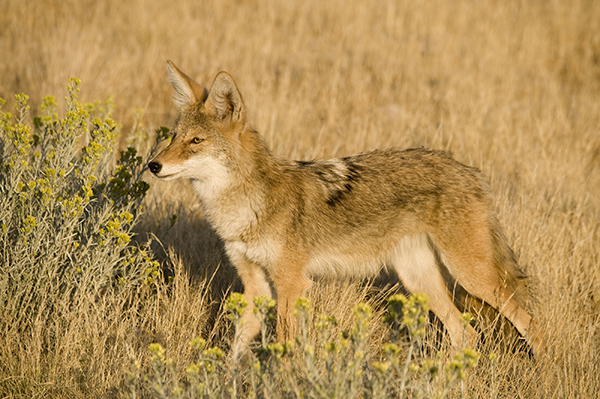
Footprints in the dirt around the chicken coop at dawn, pets acting unusually alert near the fence line, or even a subtle den entrance tucked beneath a deck—foxes are clever, highly adaptable, and fast. They’re often able to outsmart unprepared homeowners, finding ways to thrive even in urban and suburban environments. That’s where Trapper Joe’s Wildlife Control, LLC comes in. We provide humane, regulation-compliant fox removal and control services tailored to homes, farms, HOAs, and commercial properties throughout Indianapolis and surrounding areas. Our approach includes locating fox dens, safeguarding vulnerable areas, and creating a customized prevention plan that accounts for how foxes naturally travel, hunt, and think.
Owner-operator Joe Burkhart brings years of hands-on experience managing predator issues across Central Indiana’s neighborhoods and small-acreage properties. Whether you’re dealing with foxes disrupting a quiet suburban area or threatening poultry on a farm, we combine thorough inspections with calm, humane handling methods and clear, honest communication. Our mission is to keep families, pets, and livestock safe while respecting the surrounding wildlife and adhering to Indiana regulations.
Trapper Joe's Wildlife Control, LLC is fully licensed and insured, offering professional services to residential, agricultural, and commercial properties. We specialize in humane, poison-free fox pest control, ensuring safe and sustainable solutions. Our available services include den confirmation and eviction (when conditions allow), perimeter hardening using methods such as fence skirts, apron installations, gate gap closures, and fox deterrents to prevent digging or scaling. We also help protect poultry and small pets with customized strategies to deter foxes, as well as address sanitation issues and the removal of attractants that might draw foxes to your property.
For clients who require it, we provide insurance-ready photo documentation of any damage or activity we find during our thorough onsite assessments. These assessments, available for a nominal fee, are waived when you proceed with any of our fox pest services. At Trapper Joe’s, we go beyond just removing nuisance wildlife—we provide long-term wildlife control solutions to prevent future issues, giving you peace of mind and a safer environment.
Don’t wait for wildlife issues to escalate—contact us today! Our team of experienced Indianapolis fox pest removal specialists is ready to provide you with reliable, effective solutions tailored to your needs. Our services extend throughout Greater Indianapolis, encompassing Avon, Franklin, Greenfield, Fishers, Shelbyville, Plainfield, Fortville, and more. We also collaborate with agricultural enterprises, homeowner associations, and facility management professionals across Central Indiana. Call us now to schedule your assessment and get rid of foxes for good.

If you suspect a nuisance fox problem, it’s crucial to know what to look for to confirm their presence. Recognizing the typical signs of fox activity can help you determine whether these animals are active in your area and potentially causing issues. Being aware of these indicators can help you assess the situation more effectively and decide on the appropriate next steps to manage the problem. By observing these common signs, you’ll be better prepared to confirm fox activity and address any concerns they may be causing. Here are some specific signs to watch for when determining if foxes are creating trouble in your area:
Loud Noises at Night → Foxes are nocturnal animals, meaning they are most active after the sun sets. At night, they communicate using loud yipping, barking, or even screaming sounds that can be startling and are often mistaken for other animals. These vocalizations are usually heightened during mating season or when foxes are protecting their territory.
Damaged Property → Foxes often dig small holes in lawns, flower beds, or gardens as they search for insects, grubs, or buried food scraps. They may also chew on objects such as wires, garden hoses, or outdoor furniture, causing damage that can be costly to repair. This behavior is driven by their natural curiosity and need to forage for food.
Foul Smells → If a fox has decided to take up residence under your porch, deck, or shed, you might notice a strong, unpleasant odor. This smell typically comes from their urine and feces, which they use to mark their territory. The longer a fox stays in one spot, the stronger and more noticeable the smell may become.
Pet Disturbances → Outdoor pets, such as cats or small dogs, may become noticeably agitated or anxious if a fox is nearby. This is especially true if the fox has a litter of young, as they can become particularly defensive of their den. Pets might bark, hiss, or pace more frequently when sensing a fox’s presence.
To address these issues, it’s essential to take practical preventive measures. For example, you can secure garbage bins with tight-fitting lids to prevent foxes from scavenging for leftovers. Seal any gaps or access points under porches, decks, or sheds to stop them from creating dens on your property. Additionally, removing food sources like pet food left outside or fallen fruit can discourage foxes from visiting your yard. By taking proactive steps, you can reduce the chances of disturbances caused by foxes and maintain harmony with the local wildlife in your area.
If you’re finding tracks by the coop, hearing rustles along the fence at dusk, or seeing a den take shape under the deck, Trapper Joe’s Wildlife Control, LLC can help. We’ll remove foxes humanely, secure the weak spots, and reset routines so they don’t return. Schedule your onsite assessment today (fee credited with any service) and get a clear, durable plan for a fox-secure property.
Overall fox removal cost will vary based on your property size, the complexity of the fox den, and the length of your perimeter, as well as the individual services you choose. We'll always prioritize urgent protection, then focus on broader perimeter improvements, and you can rest assured our rates are fair and competitive. Call now to get started!
Foxes are creatures of habit, driven by the search for sustenance and secure harborage. They are opportunistic predators and scavengers, naturally drawn to areas that provide easy access to food, adequate cover, and convenient travel routes. For instance, bird feeders, while offering a delightful spectacle, can inadvertently attract rodents, which in turn become a food source for foxes. Similarly, open compost bins, unsecured trash receptacles, and pet food left outdoors essentially lay out a nightly buffet for these clever animals. These readily available food sources establish predictable "circuits" that foxes will repeatedly patrol.
Beyond food, foxes also seek shelter, and many residential properties offer ideal conditions. Gaps under decks and sheds, untended brush piles, or low crawlspaces beneath structures can all become attractive den sites. Foxes are remarkably adept at recognizing and patterning routines, and they will consistently test the same paths and access points until a change in their environment or our preventative measures forces them to alter their behavior.
Here at Trapper Joe's, we know how to recognize these critical signs and secure your home or business from these unwelcome guests. Common attractants that invite nuisance foxes onto your property include:

Small livestock like chickens, ducks, and outdoor rabbits are highly appealing to foxes as they are easy to catch and provide a reliable food source. Foxes are naturally opportunistic hunters, and these animals, often kept in enclosures that might not be fully secure, make them an obvious first choice when available. Properly reinforcing coops and hutches is essential to deter foxes.
Foxes are drawn to areas teeming with rodents, as these small mammals are another easy source of prey. Environments that encourage rodent populations, such as fallen birdseed beneath feeders, stacked woodpiles, or cluttered storage sheds, can quickly become hotspots for fox activity. Cleaning up spilled seed and keeping outdoor areas tidy can help reduce these attractive hunting grounds.
Compost piles and unsealed garbage bins can provide foxes with a readily available, easy-to-scavenge meal. Once foxes discover a consistent food source, they are likely to return to the same spot night after night, memorizing its location. Securing compost with a lid and ensuring trash bins are tightly closed can go a long way in preventing repeat visits from these resourceful animals.
Foxes are constantly searching for safe, secluded places to rest during the day or raise their young. Voids beneath decks, sheds, patios, or even building foundations often serve as ideal dens. These spaces are quiet, out of sight, and protected from predators or weather. Foxes may also utilize hollowed tree trunks for similar purposes, as they provide both security and concealment.
Thick vegetation along fence lines, untended brush piles, or overgrown corners of a yard offer excellent cover for foxes. These dense areas allow them to move undetected and feel safe while navigating through the environment. Such spots are perfect for foxes to rest or hide during the day, as the heavy cover shields them from view and potential threats. Keeping these areas trimmed and clear can make your yard less appealing to foxes seeking shelter.
Foxes are highly adaptable creatures that often find their way into residential areas in search of food, shelter, and safety. While they may seem elusive, certain features in your yard can attract them, turning your property into an ideal habitat. Understanding these factors can help you identify and address potential fox-friendly conditions.

Neat, oval tracks; musky scent posts; narrow scat with fur/seed; light, springy steps.
Larger, more elongated tracks; longer stride; scat often more substantial.
Meandering path; blunter nails; tends to push through rather than dig under.
Once we've thoroughly assessed the situation and confirmed the specific species of animal — be it a fox, coyote, or even a raccoon — we can then tailor our sets, barriers, and timing specifically to that animal's unique behaviors and habits. This individualized approach is crucial for ensuring the most effective and humane resolution, taking into account how each animal typically interacts with its environment and what methods will be most successful for deterrence or removal. Regrets, we do not work with stray dogs or coyotes —reach out to local animal control or DNR for any issues with stray canines/felines in your area.
If you're dealing with nuisance wildlife challenges and need expert guidance or support, don't hesitate to reach out to our team of seasoned animal removal professionals. Trust us to provide a tailored solution that prioritizes both the safety of your property and its inhabitants, as well as humane practices for the surrounding wildlife involved. Call 317-832-5840 to arrange an onsite inspection for fox pest control services, today.

Our initial step involves a thorough investigation where we meticulously survey the area. This includes identifying tracks, scat, and established trails, utilizing camera clues for nocturnal activity, and pinpointing den entrances and preferred approach routes used by foxes. We also carefully document any existing weaknesses in fences, coops, and other structures that might allow access. Following this comprehensive assessment, you will receive a detailed report of our findings, complete with photographic evidence, along with a clear, itemized plan of action tailored to your specific situation.
When the situation necessitates removal, we prioritize humane and ethical practices. Our team implements species-appropriate, low-stress capture methods that are fully compliant with all Indiana regulations and take into account any neighborhood constraints.
We strategically place our equipment to significantly reduce the risk to non-target animals, and we provide you with a detailed briefing on pet safety guidelines to observe around any set zones. This ensures the well-being of both the target animal and your domestic pets.
In instances where conditions are suitable, we employ specialized one-way den devices or carefully timed disturbances to encourage voluntary relocation of the foxes. This method allows the animals to leave the den naturally without direct handling. Crucially, we always verify that the den is completely vacant before initiating any closures or barrier work, preventing the accidental sealing of animals inside.
To prevent future intrusions, we can close the loopholes foxes exploit by implementing dig-proof fence skirts, ensuring tight gates and panels with gap covers, bottom rails, and rodent-proof thresholds, and adding scale deterrents like interior coyote rollers or top rails where climbing is observed. Coop upgrades include roof mesh, buried skirts, latch guards, and dusk-proof door routines, while crawl space and vent security are reinforced with wildlife-grade screens and durable doors.
We work with you to identify and eliminate potential attractants that draw foxes to your property. This includes addressing rodent harborage due to seed fall, improper feed storage, or accumulated clutter. We also advise on securing trash and compost bins and maintaining excellent yard hygiene. By reducing the availability of prey and minimizing enticing smells, we can significantly decrease the frequency of fox visits.
For poultry owners, we are happy to offer essential advice on establishing routine checks, implementing strict dusk lock-up times for birds, and best practices for feed storage to minimize attracting predators. For families with pets, we share effective strategies for leash use and proper outdoor lighting until the fox activity in the area subsides, ensuring the safety of your beloved companions.
Upon completion of our services, you will receive comprehensive documentation including before and after photographs, detailed barrier diagrams, and a maintenance checklist to help you keep your property secure. Qualified sealing and fence-skirt work comes with an exclusion warranty, the specifics of which will be clearly outlined in your initial estimate. Additionally, we offer seasonal re-checks in areas where fox pressure is a recurring issue each year, ensuring long-term peace of mind.
When you choose our professional fox pest control services in Indianapolis, you gain the peace of mind that comes from knowing your property is protected with expertly installed, humane barriers. This comprehensive protection is further supported by thorough documentation and valuable maintenance resources designed to help you uphold the integrity of the exclusion work. Our commitment to your long-term security includes a clear warranty for certain qualified work, providing an extra layer of assurance, along with convenient seasonal re-check options specifically tailored for areas that experience consistent fox activity year after year.
Don't leave the safety and security of your property up to chance when it comes to managing fox activity. Foxes can cause significant disruption, from threatening small pets to damaging property, making it essential to take proactive measures. Contact us today to discuss your specific concerns and let our experts design a customized animal trapping and removal solution tailored to your property’s unique needs.
Our skilled team is dedicated to providing long-term protection, giving you peace of mind knowing your home or business is secure from unwanted intrusions. Take the first step toward lasting safety and let us help you protect what matters most. Call now to schedule an assessment for a low, initial fee, which will be waived with any service. Fox pest control prices vary with property size, den complexity, and perimeter length, as well as the specific services you choose. We can phase work—urgent protection first, then broader perimeter improvements, for your convenience.
Foxes are intelligent and adaptable creatures, making their dens and hunting grounds in various locations, often surprisingly close to human habitation. Understanding their preferred spots can help in identifying potential problem areas on your property and planning effective exclusion strategies. Here are some of the most common places where we observe fox activity:
These structures offer secluded and quiet denning voids, perfect for foxes looking for a safe place to raise their young or seek shelter from the elements. The quick escape routes these locations provide make them even more ideal for a cautious fox.
When inspecting your property, pay close attention to fence lines. Look for signs such as low dig points under the fence, lifted panels, or climb and scale marks near corners, all of which can indicate easy access points foxes use to enter or exit your yard.
Foxes are notorious predators of poultry. Gaps at the base wire of enclosures, unsecured doors, or weak roof meshes are prime targets for foxes seeking an easy meal, often resulting in significant losses for chicken owners.
Natural features like hedgerows, tall grass swales, and utility corridors offer excellent cover and easy, hidden pathways for foxes to move through your property undetected, making them common areas for activity.
Loose doors or damaged vents leading to crawlspaces can offer convenient, dark shelter for foxes, providing a secure spot and a strategic vantage point for observing their surroundings without being seen.
These areas are particularly attractive to foxes. They search for easy food sources like discarded food scraps, fallen fruits, or small prey (such as rodents or insects) that are often drawn to compost, turning your garden into a potential foraging ground.
Foxes are highly opportunistic scavengers. They will readily investigate and overturn any unsecured bins, rummaging through them for food waste and other edible items.
Thick vegetation provides excellent cover for foxes to rest during the day or observe their environment without drawing attention to themselves, making these spots frequent hideouts.
Access to water is crucial for all wildlife. Ponds, streams, bird baths, or even dripping outdoor faucets can attract foxes, especially during drier periods when natural water sources are scarce.
These natural or man-made structures offer secure and protected shelters. They can serve as attractive den sites, providing warmth, safety, and a good vantage point for observing nearby activity.
Small dogs and outdoor cats are vulnerable, especially at dawn and dusk.
Foxes can quickly and repeatedly target poultry if entry points persist.
Foxes can carry mange; seek medical advice for any bites or scratches. Report suspected rabies exposure to health authorities immediately.
Foxes accustomed to human food may ignore deterrents and become bolder without corrective measures.
By understanding the typical behaviors and preferred habitats of foxes, we can learn to coexist more peacefully with these often-misunderstood creatures. This knowledge helps us minimize potential conflicts and ensures the safety of both humans and pets. If you find yourself needing professional wildlife control assistance with a fox on your property, you can trust the expert fox removal specialists at Trapper Joe's. We provide safe, humane, and effective solutions for resolving any fox-related issues, helping to restore peace of mind to your home and surroundings. Call 317-832-5840 to schedule an estimate, today.
Our approach to fox relocation strictly adheres to Indiana regulations regarding wildlife handling and disposition. The feasibility and method of relocation depend heavily on the specific context of your property and current state laws. During our initial assessment, we will thoroughly explain the compliant options available to you, ensuring all actions are legal and humane.
Absolutely. Foxes are surprisingly agile climbers, especially when it comes to fences made of chain link or rough wood, which offer easy footholds. To counter this, we often recommend installing top-rail deterrents to prevent them from getting over. Digging is an even more common method for foxes to gain entry, which is why a buried skirt around the base of your fence is crucial for effective exclusion.
Unfortunately, outdoor cats can indeed be at risk, particularly during dawn and dusk when foxes are most active. To ensure your cat's safety, we strongly advise keeping them indoors at night and supervising their outdoor time carefully until we can confirm that fox activity in your area has been resolved.
Protecting your poultry requires a multi-faceted approach. We recommend installing a buried skirt around your coop and run, using sturdy hardware cloth (not standard chicken wire) for enclosures, and ensuring all latches are secure. Implementing a strict dusk lock-up routine is also vital. We can assist with upgrading existing coops and adding roof mesh for enhanced protection.
Scent or noise deterrents typically offer only short-term relief, at best. Foxes are intelligent and adaptable, often becoming habituated to these methods quickly. For lasting solutions, we focus on structural fixes to your property and routine changes that genuinely disrupt fox behavior and stop repeat incursions.
Seeing tracks in the snow is actually incredibly useful intelligence! It helps us map the routes foxes are using to access your property. With this information, we can strategically harden your fence lines and other vulnerable points before the increased pressure of spring activity builds.
It's certainly possible. Mange is a common condition in foxes that can cause hair loss and a patchy appearance. If you observe a fox with these symptoms, it's crucial to avoid all contact and keep your pets away from the animal. We will take all necessary precautions during removal and can advise you on proper reporting procedures if there has been any human or pet exposure.
The duration of the removal process can vary depending on several factors, including the fox's behavior, the specific challenges of your property, and the methods required. Some situations can be resolved in a few days, while others might take a couple of weeks to ensure complete and humane removal. During our assessment, we'll provide a more precise timeline based on your unique circumstances.
Greenfield, Indiana
Indianapolis, Indiana
View Our Library of Wildlife Blogs
December 17, 2025
The sound is unmistakable—a frantic scratching or scurrying noise coming from directly above your head. For many homeowners, this unsettling soundtrack is the first sign that their roof has become a cozy nursery for a
December 4, 2025
Central Indiana is known for its beautiful seasons and diverse ecosystems. From the rolling hills of Brown County to the bustling neighborhoods of Indianapolis, our region is teeming with life. While spotting a cardinal
November 18, 2025
Hearing strange noises from your attic at night can be unsettling. For many homeowners in Indiana, the culprit is often a surprisingly common visitor: the raccoon. These clever, masked animals are drawn to the shelter a
Fill Out & Submit Our Email Form!